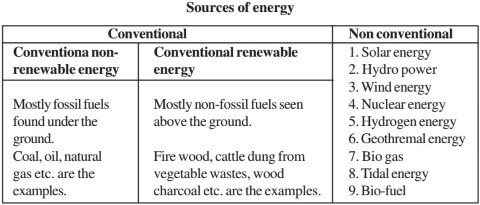Non Conventional Energy Sources Notes Pdf
- 5 Comments!

Sep 19, 2013 The comparison between the Conventional and Non-conventional sources of Energy is mentioned below: Conventional energy, such as thermal powers (from coal, petroleum, and natural gas), hydel power (from high velocity of running water) are tapped and used abundantly at present.
Sources of Energy Class 10 Notes pdf Science Physics CBSE NCERT Chapter 14? Characteristics of a good fuel: (iv) High calorific value (v) Less smoke (vi) Less residue after burning (vii) Easy availability (viii) Inexpensive (ix) Easy to store and transport? Fossil fuels: were formed millions of years ago, when plants and animal remains got buried under the earth and were subjected to high temperature and pressure conditions.
E.g.: Coal, Petroleum, etc. These fossil fuels are non renewable sources of energy and cause environmental problems due to pollution.? Thermal power plants: (i) Use coal, petroleum and natural gas to produce thermal electricity.
K-Sim® Engine provides high quality training in every aspect, from details in a single sub-system to the overall running of a loading or discharge operation, including handling of emergency situations. Engine room simulator program. Highly realistic training tool All K-Sim® Engine models are developed based on actual ship specifications and performance data, making the simulator as realistic as possible. From desktop to full mission simulators We offer cost-effective solutions to fit every requirement and budget. K-Sim® Engine can be configured from a PC desktop to an operational full mission engine room simulator using custom panels and ship equipment.
(ii) Electricity transmission is very efficient. (iii) The steam produced by burning the fossil fuels runs the turbine to produce electricity?
Hydro power plant: (Refer to figure 14.3, page no. 246 of N.C.E.R.T Text book) (i) It is the most conventional renewable energy source obtained from water falling from a great height. (ii) It is clean & non polluting source of energy. (iii) Dams are constructed to collect water flowing in high altitude rivers.
The stored water has a lot of potential energy. (iv) When water is allowed to fall from a height, potential energy changes to kinetic energy, which rotates the turbines to produce electricity.? Disadvantages of Hydro power plant (i) Highly expensive to construct. (ii ) Dams cannot be constructed on all river sites. (iii) Large areas o human habitation and agricultural fields get submerged. (iv) People face social and environmental problems.?
Non conventional sources: (1) Bio mass: o It is the source of the conventionally used fuels that are used in our country. E.g.: Cow dung cakes, fire-wood, coal, charcoal o Bio gas: It is a mixture of gases produced during decomposition of bio mass in the absence of Oxygen.
(Anaerobic Respiration). Methane is the major component of bio gas. O Bio gas plants: Animal dung, sewage, crop residues, vegetable wastes, poultry droppings, etc. Are used to produce Bio gas in Bio gas plants.
(Refer to figure 14.4, page no. 247 of N.C.E.R.T Text book) (2) Wind energy: o It can be converted into mechanical and electrical energy. O Kinetic energy of the wind is used in running of wind mills, which are used to lift water, grind grains, etc.
O Wind mill- (Refer to figure 14.5, page no. 247 of N.C.E.R.T Text book) o Advantages: (i) Eco friendly (ii) Renewable o Disadvantages: (i) Wind speed not uniform always. (ii) Needs a large area to erect series of wind mills. (iii) Big amount of investment is needed. (iv) Out put is less as compared to investment (3) Solar energy: o Solar radiations can be converted electricity through solar cells (photovoltaic cells). O Photovoltaic cells convert solar radiations directly into electricity through silicon solar cells.
O Solar cells arrange on a large flat sheets form a solar panel. O Solar cookers are painted black from outside and a large glass plate to trap solar radiations by green house effect. (Refer to figure 14.6, page no. 249 of N.C.E.R.T Text book) o Advantages of Solar cookers: (i) Eco friendly (ii) Renewable (iii) Used in rural areas. (iv) Retains all the nutrients in food due to slow cooking. O Disadvantages of solar cooker: (i) Silicon cells are expensive. (ii) Solar radiations are not uniform over earth‘s surface.
(iii) Cannot be used at night or on cloudy days. (iv) Cannot be used to make chapattis for frying as these require a temperature of 1400C or more.(Maximum temperature of 1000C only can be achieved in a solar cooker) o Other solar devices- Solar water heater, Solar furnace (4) Geo thermal energy: (i) Energy harnessed from the heat of the sun is called Geo thermal energy. (ii) Magma is formed when this heat melts the rocks. The molten rocks and hot gases are called magma (iii)The magma gets collected at some depths below the earth‘s surfaces.